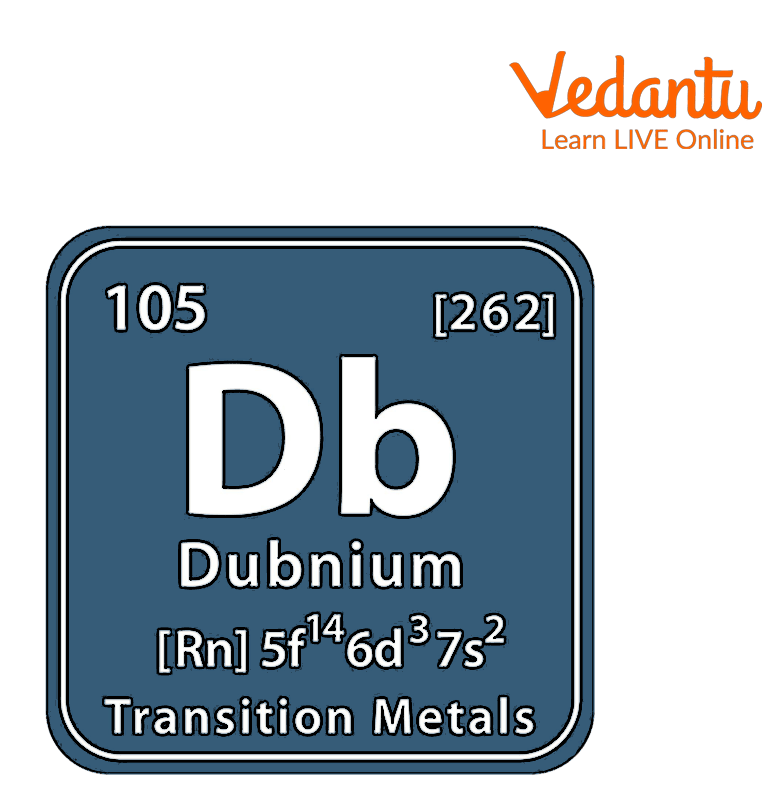




Introduction To Dubnium
Dubnium is the 105th component of the periodic table. In a periodic table, elements are organized according to their atomic number. The atomic number is the number of protons within the atom's nucleus. Dubnium has an atomic number of a105. It's located in group 5 and period seven of the periodic table of elements and is denoted by the symbol ‘Db’. Dubnium is named after Dubna, a Russian town.
A small quantity of Dubnium has been created by artificial means. The bombardment with the heavy ion linear accelerator can facilitate the making of various isotopes.

Dubnium
What is Dubnium?
Dubnium is a radioactive element created through an experiment with the symbol (Db). The atomic number 105 of the synthetic component Dubnium is represented by its symbol Db.
History of Dysprosium
Element-105 was discovered in 1968 by a team led by Georgy Flerov at Joint Institute for Nuclear Research (JINR). The isotope-261 of the element-105 was created by a team led by Albert Ghiorso at the Lawrence Berkeley Laboratory (LBL) in 1970.
At first, both teams gave totally different names to the element-105; the JINR group called it Neilsbhorium and the LBL group called it hahnium; both were named after outstanding scientists. Eventually, the International Union of Pure and Applied Chemistry (IUPAC) determined it should be known as Dubnium.
Dubnium doesn't occur naturally in Earth’s crust; it can only be prepared in an artificial manner in particle accelerators. All the isotopes of Dubnium that are characterized to date are obtained synthetically.
Dubnium Electron Configuration
Dubnium atomic number is 105 and electron configuration is
Chemical Properties of Dubnium
The chemical properties have only been studied in theory and a few of the properties have been verified in single-atom experiments.
Calculations of solution chemistry indicate that the dubnium compounds that display an oxidation state of ‘+5’ are way more stable than those that show states of ‘+2’ and ‘+3’.
Calculations in solution chemistry additionally dictate that the dubnium compounds that show an oxidation number of ‘+5’ are comparatively more stable than Nb and tantalum compounds of the same state.
The complexion tendency and ability of dubnium are expected to be the same as the group-5 elements.
Physical Properties of Dubnium
Dubnium is an artificial element that's quite difficult to characterize.
The atomic mass of the Db is 261.9.
The density, boiling point, and melting point of dubnium are unknown as of now.
The longest-lived isotope of dubnium features a half-life of twenty-eight hours; this makes its estimation of properties very difficult. So far, studies have only been performed on single atoms.
The atoms of the solid-state dubnium square measure expected to arrange themselves in a body-centered cubical structure.
The isotopes that have comparatively long half-lives square measure much harder to produce; this additionally poses challenges within the study of dubnium.
Uses of Dubnium
Since Dubnium isn't produced in high amounts and it doesn't exist even on the earth’s crust. Therefore there are no such practical applications of this metal except the research areas.
The metal has not also proved any harmful effects on health and the surroundings since it tends to decompose within a short period.
Interesting Facts
Dubnium is named for the town in Russia where it was first created, Dubna.
Dubnium doesn't exist naturally on Earth.
Dubnium was first created by bombarding americium-243 with neon-22 atoms.
Conclusion
The valency of Dubnium is five and the dubnium elements have an atomic radius of 139 pm. The element 105 (atomic number) shows the silver color and the dubnium symbol is Db. Dubnium was discovered in 1970 and the melting and boiling point isn't known, however. It's a synthetic component. It is a transuranic element. It's created unnaturally by bombarding Cf 249 isotopes with N 15. It's harmful in nature because of radioactivity.






FAQs on Dubnium
1. What type of research is dubnium used for?
Dubnium's most stable isotope, dubnium-268, features a half-life of about thirty-two hours and decays through spontaneous fission. Because of the small amounts produced and its short half-life, there are presently no uses for dubnium outside of basic research. Dubnium is an element that was created in a laboratory using bombardment, which may be a technique of making new, totally different components by shooting tiny particles or different elements at them. A Russian team, led by Georgy Flerov created the component by bombarding americium-243 with neon-22 in 1968.
2. What is the reactivity of Dubnium?
The reaction of dubnium with bases is as follows: As only a bit of dubnium has ever been made, its reactivity with bases is unknown. One would predict its behavior to be almost like that of Ta (immediately above dubnium within the periodic table) and Nb (two places above). It's going to only be produced in a nuclear facility. Dubnium doesn't exist naturally on Earth. The element dubnium was the subject of a naming disceptation. At present, it's only utilized in research.
3. Is dubnium a solid, liquid, or gas?
Dubnium may be a chemical element with the symbol Db and atomic number 105. Dubnium may be solid at room temperature and classified as a transition metal. Dubnium (pronounced as DUB-nee-em) belongs to the family of transition metals and is denoted by the chemical symbol Db. it has twelve isotopes out of which the most stable one is dubnium-268 with a half-life of thirty-two hours.












